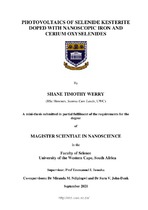| dc.description.abstract | As the demand for energy is constantly increasing, researchers are looking at various methods of energy production. Following the rise of solar energy becoming a major player, researchers are looking at kesterite materials, Cu2ZnSn(S,Se)4 (CZTS) for photovoltaic applications as they demonstrate many excellent characteristics making them highly suitable for use in thin-film solar cells. Consequently, there are major drawbacks of using kesterite materials for photovoltaic applications such as their point defects and secondary phases. Cerium and iron oxyselenides (Ce2O2Fe2OSe2) are a member of the chalcogenide family and by introducing this chalcogenide into the kesterite structure there would be an improvement in the semiconducting property of the kesterite material. The focus of this research is to dope the kesterite material with nanoscopic cerium and iron oxyselenides in order to reduce the band gap of the kesterite material, thereby improving its light absorption, thus, resulting in a more efficient photovoltaic effect. | en_US |

